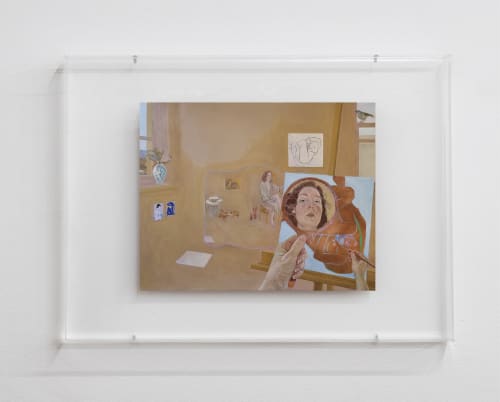Dear... Natasha,
If a novel can describe the world we live in, a portrait assumes the perilous and impossible task of describing a single human. Natasha Walsh stepped quietly but powerfully onto the Sydney art stage in 2018 with an awkwardly wonderful self portrait painted on copper. That little painting won Walsh The Brett Whiteley Travelling Art Scholarship the same year.
Rembrandt was one of the earliest and most notable painters to use copper. Garlic juice was first rubbed on to the copper to assist paint attaching itself to the slippery surface. Candle light gives Rembrandt’s early self-portraits a haunting glow, hiding the opalescent copper surface buried under layers of oil paint, white primer and garlic. Walsh approaches the copper far more directly. Oil paint slides gently across the raw copper surface in her mesmerizing little paintings. Her interest in the occult, Hilma af Klint and tarot cards mirrors the explosive minutiae of chemical reactions occurring under every colour, entwined with every painterly decision, across the surface of the works - an alchemy of calmness. The copper is primed clear so that the copper will continue to cast its own reflections through Walsh’s marks and scratches for generations to come.
Walsh’s first solo exhibition gives a nod not only to the ancient use of copper as a surface for painting but also to artists who have inspired and come before her - Whiteley Maar Claudel Dali Bourgeois Rothko, all ghosts in Walsh’s intensely personal works. The dead artists become a vehicle Walsh uses to continue telling the story she started in 2018, about herself, about one humans experience of living on the planet, jumping gently off the shoulders of so many artists before us. As the communities we live in continue to complicate themselves at dizzying pace Walsh gives us back the solace of being alone, staring into a mirror, being in ones own company, silent, honest and steadfast. Walsh is not seemingly always comfortable in her own presence though. Ambitiously awry constructions place her on a stage that is as beautiful as it is difficult. The copper shines through, an uneasy platform for Walsh’s intriguing paintings.
Portraiture for me is about recording moments, between sitter and artist, cloaked in the history of the genre, but stepping forwards to record now. Each mark is a cipher about a moment quietly sitting together, one observing the other, the other trusting the observation, or not. Natasha Walsh records being alone. The sitter is also the artist. In an era where we are submerged by social media and community is rapidly globalizing, sitting alone is surely a bastion of our own purew humanity. Making art requires precense of mind meaning the artist is far from disengaged. Walsh urges us to share that solitude, remember ourselves, through herself. I sense in her paintings anxiety, pathos, playfulness and rigour but also an ambitiously optimistic creative urge. Together in the artist’s hands Walsh’s paintings are becoming a profound record of all of us in this intense age.
Love,
Ben Quilty

